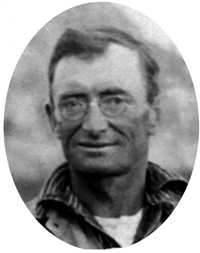
Harold D’acre (pronounced “Day-ker”) Robinson Lowe was born in Liverpool, England on February 1, 1886, one of four sons born to Matthew Booth Lowe and his wife Sarah Ann of St. Helen’s, Lancashire, England. The entire family moved to Toronto around 1905 and farmed there.
In 1909 they moved to Alberta and were among the first homesteaders to settle and farm in the Big Stone district, about 50 km NE of today’s Dinosaur Provincial Park (DPP). Farming life was tough on the Lowes with drought, poor crops, Harold’s home burning down, and grass fires burning valuable feed for their animals. The family moved to Youngstown, AB around 1914, where they provided a variety of handyman jobs such as digging cellars; tilling gardens; selling cream separators, horses and coal; breaking and training horses for WWI military use overseas; taxi service; and hauling wagon loads of all types. Around 1920 some of the family (Harold included) moved to Drumheller and for several years ran one of the first bus and taxi companies in that then rough and rowdy coal town. The rest of the Lowe family soon followed suit. Despite being a Drumheller resident, Harold also continued farming his land in the Big Stone district until at least 1923.Early in the 1925 Geological Survey of Canada’s (GSC) field season near Tolman Bridge, AB Charles M Sternberg suddenly found himself without a teamster. The departing man recommended Harold Lowe and a field partnership lasting from 1925-1937 was born. Harold was an ideal field man. Though of slight build, years of hard labor on the farm had made him wiry and strong. He was a hard worker familiar with excavation tools and their use, horse and wagon care/operation, loading and hauling heavy wagon loads, and motor vehicle maintenance. Owing to the Great Depression and other interruptions, Harold did not work for Sternberg every year, but did put in six full field seasons (1925-1926,1928,1935-1937), not only in Alberta, but in 1935 also assisted Sternberg in Saskatchewan and Manitoba. While the Royal Ontario Museum worked in Alberta during the Depression, Harold only worked for the GSC under Sternberg’s supervision. In the field he quickly became Sternberg’s “right hand man”.
After his last field season, Harold had a number of jobs in Drumheller. He was a coal miner at the Hy-Grade Mine, manager of the St. Regis Hotel and then worked at Whitlock Lumber. He and his family (wife Daisy (1889-1973); son Don (1932-); and two daughters Connie (1923-1976) and Georgina (1928·2006)) moved away from Drumheller in 1944, starting a new life in Burnaby, BC. There he worked as a caretaker and maintenance man at a restaurant and later was a shipper/receiver at a car parts dealership. He suffered a fatal heart attack on September 5, 1952, age 66 (Anonymous, 1952a-b). The former Lowe home in Drumheller still exists and is now converted into the Old Grouch’s Restaurant, a popular hangout for some Tyrrell Museum staff.
Harold’s name briefly comes up in several published histories of early dinosaur collecting in Alberta (Russell, 1966:26; Dodson, 1996:160; Spalding, 1999:89). The taxonomically problematic centrosaurine Monoclonius Lowei was named after him, the only civilian so honoured by M Sternberg who erected 37 new species of western Canadian dinosaurs or dinosaur ichnospecies.
Despite these recognitions, who Harold Lowe was and his full contributions to Albertan vertebrate palaeontology are largely lost on most of the palaeontological community. This note is excised from a much larger and nearly completed project on the Albertan palaeontological contributions of Harold Lowe which will be published elsewhere (Tanke, in prep.). During Harold’s fieldwork in Alberta he made some significant ceratopsian discoveries and/or helped collect same in four of the six summers he was employed by the GSC. These are briefly reviewed here:
1925
Downstream of the Tolman Bridge, Harold finds and helps collect CMN 8882 ceratopsian scattered skull, jaws and teeth. This specimen has not been prepared and Sternberg considered it as “possibly not Anchiceratops”. Harold also helps excavate CMN 8547 a ct. Anchiceratops complete postcranial skeleton with fragments of frill. This is the panel mounted specimen which has been on display at the Canadian Museum of Nature (Ottawa) since about 1927.
1928
In today’s DPP, Harold finds and helps collect CMN 8801 (quarry 63) Chasmosaurus russelli, skull and partial skeleton.
1936
Work was again conducted in DPP. CM Sternberg’s 1936 field notes (Sternberg, 1936) for July 8 mention Harold collecting a ~small crest” of a ceratopsian, but no other details are given. A ceratopsian skeleton (possibly quarry 98) was explored July 29 and abandoned the next day.
Fieldwork was also done in support of dinosaur exhibits underway at the Calgary Zoo Prehistoric Park. Dinosaur specimens (including ceratopsian) were collected by Harold and crew 10 create a simulated bonebed exhibit at the Zoo.
1937
This was Harold’s last summer of fieldwork and the most successful one for the discovery and collection of ceratopsians. In the Manyberries/Onefour, AB district the following specimens were secured: Field No. 1-1937. Monoclonius· partial skull (later discarded due to poor quality). CMN 8802. Chasmosaurus russelli skull and lower jaws. Described in Sternberg, 1940 and accidentally destroyed jaws saved during a move. CMN 8797. Scattered pieces of small centrosaurine ceratopsian skull: left side of face with orbital rim; ?frontal, prefrontal, jugal, squamosal. MN 9813. Part of crest. Found by Harold and described by Langston as Anchiceratops. . Parts of small centrosaurine ceratopsian skull: 2 squamosa Is, part of parietals, 1 quadrate, 1 ?prefrontal, 2 postorbitals, 2 horncores and other skull pieces; found by Harold. CMN 8790. “Monoc/onius· skull. Described in Sternberg, 1940 as Monoc/onius lowei; named after Harold. Field No. 16-1937. Large orbital horn core; rest of fragmentary skull not collected.